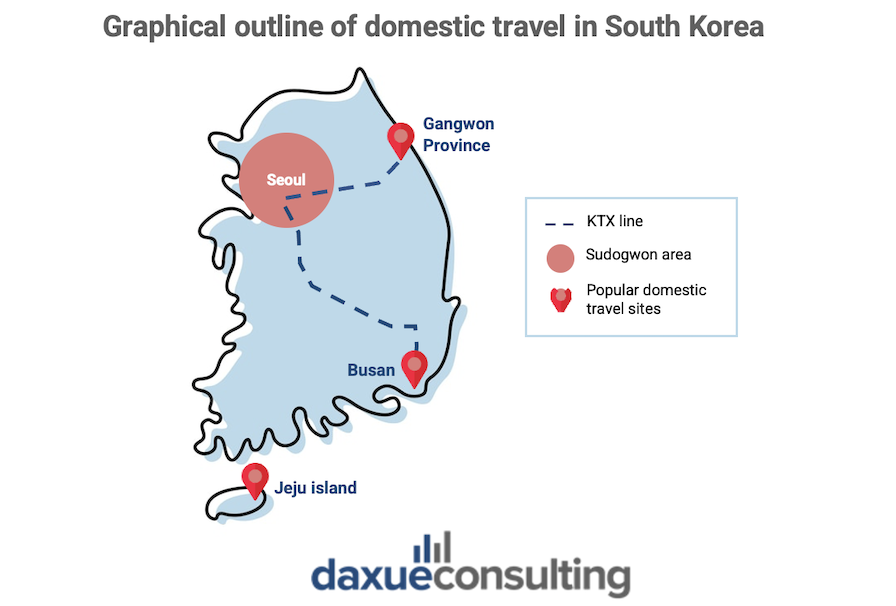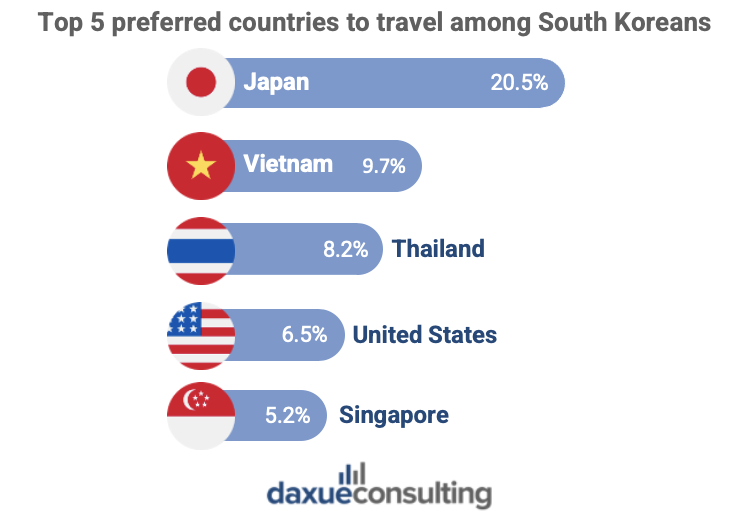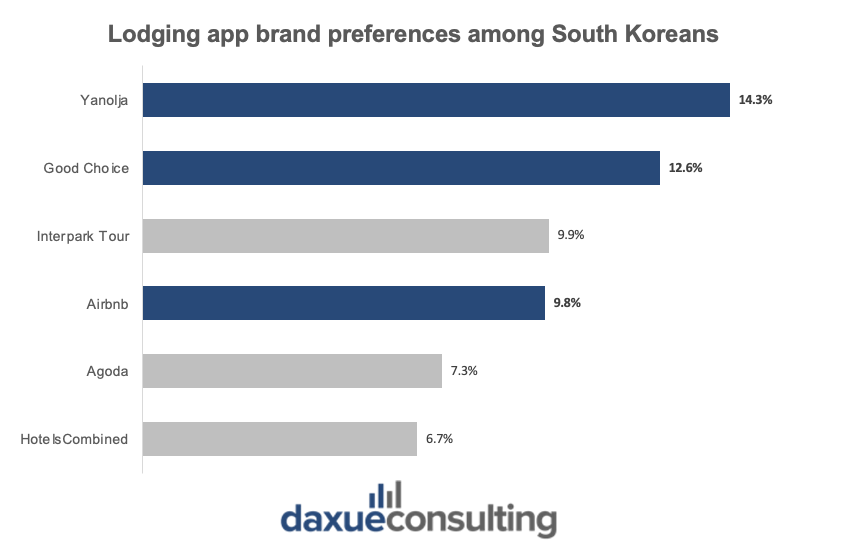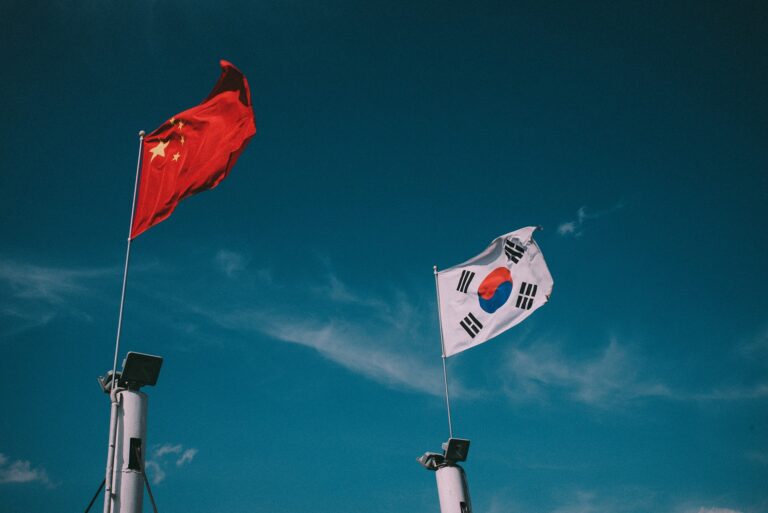The number of Korean travelers is returning to normalcy, but consumer habits will never be the same. From destinations, to lodging, and even the rise of online travel, this South Korea Travel Trends report exposes the up and coming trends.
Download to learn:
- Where are the top international and domestic travel destinations for Korean tourists
- What are the newest travel trends after the COVID-19 pandemic
- What apps do Korean travellers use for booking trips
Key Stats:
- There was a 104% increase in travelling with children between January 2020 and 2021
- Japan is the No. 1 country for international travel, accounting for 20% of Korean international trips, followed by Vietnam and Thailand.
- 4 out of 10 Koreans enjoy online traveling, which is experiencing trips via travel vlogs, photos and articles.
- Searches for ‘camping sites’ on T-map increased by 54% between 2021 and 2020.
Tourism in South Korea is growing with the impact of social media. Hallyu and cultural elements of Korea attract an increasing number of international tourists coming to South Korea. At the same time, domestic Korean travelers look for convenient and inexpensive travel options to local destinations. The consequence of the pandemic has left with new forms of travel like Hocance and online travel. Digital technology and retail platforms are developing to provide travel-related services and products as well.
South Korea’s airline industry
The current airline industry in South Korea is dominated by Korean Air and Asiana Airlines, as they take up most of the international routes. Low-cost airlines, such as T’Way, Jin Air, and Air Seoul are growing options for domestic and Asian routes.
Social media impacting tourism
Traveling is becoming widespread on social media as people increasingly share their travel experiences with pets, with children, or by themselves. According to Korea Tourism Organization, there was a 65% rise in monthly average mentions regarding traveling with pets, a 104% rise in traveling with children, and a 13% rise in traveling alone from January 2020 to January 2021. Travel influencers on social media help promote tourism, especially among the younger generation.
Who are South Korean domestic travelers?
As international travel was put on halt due to the COVID-19 pandemic, South Korean travelers searched for local destinations. Busan and coastal cities in Gangwon Province are popular because of the convenient transportation. KTX or high-speed rail system connects Sudogwon (metropolitan area of Seoul and cities nearby Seoul) to most big cities. In addition, Jeju Island is popular for its beautiful nature and unique sub-tropical climate.

Source: Daxue Consulting, Graphical outline of domestic travels in South Korea
How has the COVID-19 pandemic affected the South Korean tourism industry?
While the COVID-19 pandemic has put a halt on domestic and international travel especially, it has also led to the discovery of new types of traveling. Hocance is a new term that combines hotel and the French word vacance (vacation), meaning vacation enjoyed in hotels, without traveling outdoors. Such a convenient and hygienic method of traveling that avoids interactions with people gained attention, especially during the pandemic.

Source: Korea Tourism Organization, designed by daxue consulting, Top 10 lodging related keywords
Online travel, which became an alternative option to real travel during the pandemic, remains a convenient and cost-efficient choice for Korean travelers. Digital content, such as videos on social media and online exhibitions are advancing to give a similar effect as traveling. People can watch videos shared on social media to enjoy realistic travel experiences or the aesthetic scenery of tourist attractions at home. Additionally, online exhibitions continue to create a more interactive and immersive experiences for virtual travelers. The National Museum of Korea launched VR (virtual reality) online exhibition starting from the pandemic. Online travel cannot replace real travel experience completely. Yet, technology is advancing to better mimic the real experience and deliver a similar feeling even when traveling virtually.

International travel after the pandemic
After loosened regulations for traveling to South Korea, foreign tourists, mostly from nearby Asian countries and the United States are flocking to Seoul. Korean street food popularized by YouTube channels brings foreigners to traditional markets and Myeongdong shopping street. Medical tourism is another significant influence. Foreigners come to Seoul seeking cheap medical treatments and surgeries, as well as widely known Korean plastic surgeries. Additionally, Hallyu fans of K-beauty, K-Pop and K-Hip Hop come to South Korea to watch performances of their favorite idol group or join dance classes at famous dance studios like 1MILLION DANCE STUDIO.
Now that the pandemic is ending, Korean consumer demand for international travel is returning. However, 41% of South Korean travelers are concerned with price when choosing their travel destinations. As a result, closely located Asian countries such as Japan, Vietnam, and Thailand are the top travel destinations for South Koreans.

Emerging travel methods among young Korean travelers.
Among the younger generations who seek new experiences and self-growth, long-stay tourism and working holidays are appealing options for travel. Long-stay tourism refers to traveling in one region, usually small rural cities, for about a month. It allows a getaway from the stressful, competitive South Korean society, and allows relaxation, self-exploration, and a ‘slow life’ experience. On the other hand, working holiday uses a special type of visa that enables Korean travelers in certain countries to live in the country for six months to a year and labor for return. Working holiday is a form of self-development that helps with language training, making foreign friends, and having a foreign stay experience.
Digital travel platforms in South Korea
Booking platforms are popular travel-related smartphone applications. The leading players in the market are Yanolja and Good Choice. They are domestic-only travel platforms that provide booking services for accommodations, leisure activities, and entertainment tickets. Although regulations in South Korea prohibit local Koreans from using Airbnb service for local stays, Airbnb remains third-ranked travel app by targeting international travelers for homestays that emphasize South Korean culture.

KakaoTalk, the leading messaging service platform in South Korea, provides mobile commerce services that can improve consumer interaction and increase sales. For instance, KakaoTalk Gift allows users to send or receive online gift cards for purchasing airline tickets, while KakaoTalk Shopping promotes time-limited special deals for travel packages, accommodations, or entertainment.
The leading e-commerce platforms Naver and Coupang also offer travel-related services convenient and beneficial for users. Both Naver Travel Products and Coupang travel comprise advanced search system that provide time-relevant and standardized information to users. Naver Shopping Live and Coupang Live are live e-commerce platforms that further promote time-limited special deals for travel products.
Key Takeaways about South Korea travel trends
- The travel industry in South Korea, though the growth was halted by the Covid-19 pandemic, continues to expand rapidly due to the impact of Hallyu and K-culture.
- Traveling is widespread on social media as people share their travel experiences with children, with pets, or alone. Travel influencers also promote tourism, making travel become more desirable.
- New Korea travel trends are rising. For instance, Hocance and online travel emerged as hygienic and convenient methods of travel. Additionally, the younger generation seeking new experiences and self-growth enjoy long-stay tourism and working holidays.
- As the travel restrictions loosened globally, foreign travelers continue to visit Seoul for Korean street food, cheap medical services, K-Hip Hop, and K-Pop. On the other hand, Korean travelers desire to travel internationally to nearby Southeast Asian countries.
- Digital platforms are advancing to provide travel-related services. For instance, lodging apps are competing to grasp domestic and international tourists, big e-commerce platforms add tailored services for travel products.





